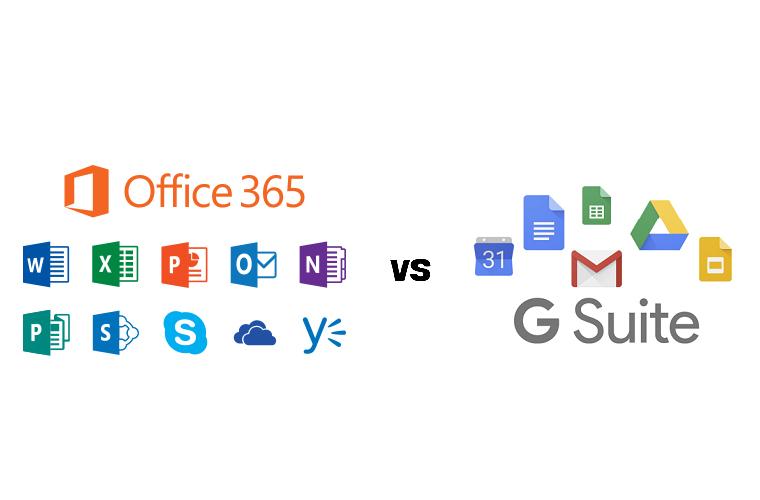G Suite and Office 365 are today’s biggest and most widely used productivity suites. Between the two you get applications for everything from creating simple document files to automating database processing using mathematical formulas.
Comparing the two can become a confusing maze of pros and cons and feature lists. Below we’ve covered the most significant points business owners will want to consider when making choosing plans.
G Suite vs Office 365: Features and Pricing
As one of the biggest–and oldest–productivity suites on the scene, Microsoft’s Office 365 comes with tools nearly everyone who’s worked at a computer has fiddled with at some point like Word or Powerpoint. Scaling the familiar to perform at the enterprise-level makes Office 365 a great option for organisations with more than 3 to 4 people.
Microsoft makes multiple tiers available for businesses of any size. The higher tiers come with a rich list of advanced features but for the purpose of brevity, we’ve covered only important features for a quick review:
Office 365 Business (£7.90)
- No business email
- 1 TB of OneDrive cloud storage per user
- All desktop, web, and mobile versions of Office apps
Office 365 Business Premium (£9.40)
- Business emails
- Access to Microsoft Exchange
- Access to Teams, a task management and communication app that lets you host online meetings and video calls with up to 250 people
- Access to SharePoint, a tool that lets businesses create internal websites for data management and resource libraries
Office 365 Business Essentials (£3.80)
- Business email
- Web and mobile only versions of Office apps
Office 365 E1 ($8 / £6.21)
- Web only version of Office apps
- 50GB of space for email on Outlook
- Skype for Business
- 1TB of storage
Office 365 E3 ($20 / £15.53)
- Unlimited OneDrive storage
- Data loss and encryption features
- Intelligent protection controls that automatically manage sharing of sensitive content across Outlook and OneDrive
- Email archiving
- Legal Hold, which can lock documents from getting erased by users
Office 365 E5 ($35 / £27.19)
- Added protections against phishing campaigns
- The same intelligent sharing protection controls in E3, extended to chats in Microsoft Teams
- Customer Lockbox, a feature that restricts all third-parties, including Microsoft personnel, from accessing the company’s content without explicit approval
- Advanced supervision features that helps a company stay compliant with policies and avoid unauthorised data sharing
While the most popular app on GSuite is probably it’s email client–Gmail–its work apps are quickly gaining ground in business. The suite comes with office apps that mirror Office 365’s nearly purpose for purpose. You have Google Docs for Microsoft Word, Google Sheets for Excel, and Google Slides for Powerpoint.
Unlike Office 365 Google has pared down their plans to only 3 tiers, whose notable features are listed below:
G Suite Basic (£4.60)
- Business email
- 30 GB of storage
G Suite Business (£9.20)
- Unlimited cloud storage
- Cloud Search, a feature that lets you scour across all your data on GSuite for files and documents
- Vault, which lets you track and export reports on user activity
- A basic app maker
- An archiving feature for emails and chats
G Suite Enterprise (£20)
- Anti-data loss and sharing controls for Gmail and Drive
- Email encryption through S/MIME
- Admins can require users to input a security key before using Gmail
- The ability to run data from Gmail through BigQuery, a tool that crunches huge data sets
Office 365 gives businesses a wide pool of options, ideal for organisations who have a clear idea of what they need. GSuite makes the choice easier with only 3 options, so you don’t get decision paralysis when comparing all the different features and pros and cons.
Entrepreneurs eyeballing Office 365’s higher Enterprise tiers should know that the plans are billed annually, which means that initial payout will be larger.
G Suite vs Office 365: Storage
Office 365’s cheapest subscription plan comes with a generous 1TB of storage per month. In comparison, GSuite’s Basic plan lags far behind with only 30GB of free space. A nearly useless amount, considering that small to medium-sized businesses process an average of 47 terabytes of data.
However, larger organisations or those whose business requires crunching mountains of data will find that unlimited storage capacity is cheaper with GSuite Business, which retails for $12 per user. Unlimited storage only comes with the pricier E3 and E5 tiers for Office 365. And even at these plans the unlimited storage comes with a footnote: users are only given 1TB at the beginning. You can request for an increase once you near 90% capacity, a task that requires users to contact Microsoft support–an extra step that may seem inconvenient for some.
Businesses who have less than 5 employees should also consider that there is no unlimited storage plan for organisations of this size. Instead, both Office 365 and GSuite provision each user with 1TB of storage.
G Suite vs Office 365: Collaboration
Both GSuite and Office 365 are built with features that allow you to share files and comment and make revisions. However, real-time collaboration is where GSuite shines. With a Google Document or Spreadsheet, any number of people can dive in and see work or changes as they’re being made. Users don’t have to send files back and forth, they can simply join in the bustle by clicking a link.
While there are web versions of Office 365, the features pale in comparison to their desktop alternatives. GSuite is the clear winner if you’re looking to mimic collaborative work as it happens in the office.
G Suite vs Office 365: Ease of Use
Office 365 has over 180 million active users, with 1 in 5 employees using it for work. We can expect more to come on board after the suite’s induction into Apple’s App Store earlier this year.
Widespread adoption means that working with outside partners who use the same apps will be easier, as there’ll be less need for tricky conversions that occasionally result in ruined formats or lost data. You can send your files to a co-worker or client, and be quite sure that they won’t have trouble opening it.
G Suite vs Office 365: User Interface
Office 365 apps are powerful, yet often suffer from feature bloat. The average SMB user probably won’t know and won’t need to know what half of the buttons on Word or Excel does. While it may be nice to have options, GSuite’s streamlined and pared down interface makes for easier navigation.
G Suite vs Office 365: The Verdict
GSuite’s simple and straightforward design makes it the obvious choice for entrepreneurs who are running the show by themselves, or work with only a handful of people. It’s also best for teams who regularly collaborate and need generous, easy to access cloud storage for heavy files and documents.
Office 365, on the other hand, is better suited for businesses who have multiple teams or need more flexible and powerful tools for data processing. It also offers far more choices for businesses who are looking for a middle ground between GSuite’s Business and Enterprise tiers.
Our IT support experts offer complete Office 365 support and consultancy so if this guide has swayed you in the direction of Microsoft’s offering, then why not give us a call to find out more.
ALL ARTICLES
